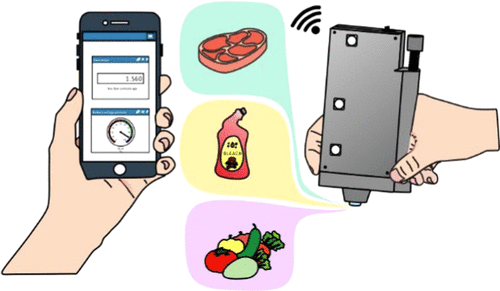Our official English website, www.x-mol.net, welcomes your feedback! (Note: you will need to create a separate account there.)
BioChemPen for a Rapid Analysis of Compounds Supported on Solid Surfaces
ACS Sensors ( IF 8.9 ) Pub Date : 2021-09-23 , DOI: 10.1021/acssensors.1c01540 Yu-Ting Chao, Gurpur Rakesh D. Prabhu, Kai-Chiang Yu, Jia-You Syu, Pawel L. Urban
ACS Sensors ( IF 8.9 ) Pub Date : 2021-09-23 , DOI: 10.1021/acssensors.1c01540 Yu-Ting Chao, Gurpur Rakesh D. Prabhu, Kai-Chiang Yu, Jia-You Syu, Pawel L. Urban

|
We present BioChemPen, a portable wireless biosensor device for rapid analysis of substances adsorbed on solid surfaces. The device takes advantage of (bio)luminescent reactions taking place in a hydrogel matrix. In a typical embodiment, the active element of this device is a hydrogel disk (chemotransducer) containing enzyme(s), electrolyte solution, and all of the necessary substrates. When the hydrogel is exposed to a solid sample surface containing the target analyte, light is produced. A photoresistor (phototransducer), placed in close proximity to the hydrogel disk, detects the light. The operation of the BioChemPen is enabled by a MicroPython PyBoard microcontroller board and other low-cost electronic modules. The obtained results are immediately uploaded to the Internet cloud. In one application, we demonstrate an analysis of hypochlorite-containing cleaning agents present on the surfaces of daily use objects by an assay based on hydrogel embedded with luminol and hydrogen peroxide. In another application, we use hydrogel embedded with luciferin, luciferase, and pyruvate kinase to detect adenosine triphosphate (ATP), and adenosine diphosphate (ADP), and link the ATP content with meat freshness. Lastly, we demonstrate the detection of organophosphate pesticides present on vegetables with the hydrogel containing acetylcholinesterase, choline oxidase, and horseradish peroxidase. The limits of detection for sodium hypochlorite, ATP, ADP, and chlorpyrifos-methyl (a pesticide) were 7.95 × 10–11, 2.73 × 10–13, 2.35 × 10–12, and 2.59 × 10–10 mol mm–2, respectively.
中文翻译:

BioChemPen 用于快速分析支持在固体表面上的化合物
我们展示了 BioChemPen,这是一种便携式无线生物传感器设备,用于快速分析吸附在固体表面上的物质。该装置利用在水凝胶基质中发生的(生物)发光反应。在一个典型的实施例中,该装置的活性元件是包含酶、电解质溶液和所有必需底物的水凝胶盘(化学换能器)。当水凝胶暴露于含有目标分析物的固体样品表面时,就会产生光。靠近水凝胶盘放置的光敏电阻(光传感器)检测光。BioChemPen 的操作由 MicroPython PyBoard 微控制器板和其他低成本电子模块实现。得到的结果会立即上传到互联网云。在一个应用程序中,我们通过基于嵌入鲁米诺和过氧化氢的水凝胶的分析展示了对日常使用物体表面存在的含次氯酸盐的清洁剂的分析。在另一个应用中,我们使用嵌入荧光素、荧光素酶和丙酮酸激酶的水凝胶来检测三磷酸腺苷 (ATP) 和二磷酸腺苷 (ADP),并将 ATP 含量与肉类新鲜度联系起来。最后,我们展示了使用含有乙酰胆碱酯酶、胆碱氧化酶和辣根过氧化物酶的水凝胶检测蔬菜中存在的有机磷农药。次氯酸钠、ATP、ADP 和甲基毒死蜱(一种农药)的检测限为 7.95 × 10 在另一个应用中,我们使用嵌入荧光素、荧光素酶和丙酮酸激酶的水凝胶来检测三磷酸腺苷 (ATP) 和二磷酸腺苷 (ADP),并将 ATP 含量与肉类新鲜度联系起来。最后,我们展示了使用含有乙酰胆碱酯酶、胆碱氧化酶和辣根过氧化物酶的水凝胶检测蔬菜中存在的有机磷农药。次氯酸钠、ATP、ADP 和甲基毒死蜱(一种农药)的检测限为 7.95 × 10 在另一个应用中,我们使用嵌入荧光素、荧光素酶和丙酮酸激酶的水凝胶来检测三磷酸腺苷 (ATP) 和二磷酸腺苷 (ADP),并将 ATP 含量与肉类新鲜度联系起来。最后,我们展示了使用含有乙酰胆碱酯酶、胆碱氧化酶和辣根过氧化物酶的水凝胶检测蔬菜中存在的有机磷农药。次氯酸钠、ATP、ADP 和甲基毒死蜱(一种农药)的检测限为 7.95 × 10 胆碱氧化酶和辣根过氧化物酶。次氯酸钠、ATP、ADP 和甲基毒死蜱(一种农药)的检测限为 7.95 × 10 胆碱氧化酶和辣根过氧化物酶。次氯酸钠、ATP、ADP 和甲基毒死蜱(一种农药)的检测限为 7.95 × 10–11、2.73 × 10 –13、2.35 × 10 –12和 2.59 × 10 –10 mol mm –2。
更新日期:2021-10-22
中文翻译:

BioChemPen 用于快速分析支持在固体表面上的化合物
我们展示了 BioChemPen,这是一种便携式无线生物传感器设备,用于快速分析吸附在固体表面上的物质。该装置利用在水凝胶基质中发生的(生物)发光反应。在一个典型的实施例中,该装置的活性元件是包含酶、电解质溶液和所有必需底物的水凝胶盘(化学换能器)。当水凝胶暴露于含有目标分析物的固体样品表面时,就会产生光。靠近水凝胶盘放置的光敏电阻(光传感器)检测光。BioChemPen 的操作由 MicroPython PyBoard 微控制器板和其他低成本电子模块实现。得到的结果会立即上传到互联网云。在一个应用程序中,我们通过基于嵌入鲁米诺和过氧化氢的水凝胶的分析展示了对日常使用物体表面存在的含次氯酸盐的清洁剂的分析。在另一个应用中,我们使用嵌入荧光素、荧光素酶和丙酮酸激酶的水凝胶来检测三磷酸腺苷 (ATP) 和二磷酸腺苷 (ADP),并将 ATP 含量与肉类新鲜度联系起来。最后,我们展示了使用含有乙酰胆碱酯酶、胆碱氧化酶和辣根过氧化物酶的水凝胶检测蔬菜中存在的有机磷农药。次氯酸钠、ATP、ADP 和甲基毒死蜱(一种农药)的检测限为 7.95 × 10 在另一个应用中,我们使用嵌入荧光素、荧光素酶和丙酮酸激酶的水凝胶来检测三磷酸腺苷 (ATP) 和二磷酸腺苷 (ADP),并将 ATP 含量与肉类新鲜度联系起来。最后,我们展示了使用含有乙酰胆碱酯酶、胆碱氧化酶和辣根过氧化物酶的水凝胶检测蔬菜中存在的有机磷农药。次氯酸钠、ATP、ADP 和甲基毒死蜱(一种农药)的检测限为 7.95 × 10 在另一个应用中,我们使用嵌入荧光素、荧光素酶和丙酮酸激酶的水凝胶来检测三磷酸腺苷 (ATP) 和二磷酸腺苷 (ADP),并将 ATP 含量与肉类新鲜度联系起来。最后,我们展示了使用含有乙酰胆碱酯酶、胆碱氧化酶和辣根过氧化物酶的水凝胶检测蔬菜中存在的有机磷农药。次氯酸钠、ATP、ADP 和甲基毒死蜱(一种农药)的检测限为 7.95 × 10 胆碱氧化酶和辣根过氧化物酶。次氯酸钠、ATP、ADP 和甲基毒死蜱(一种农药)的检测限为 7.95 × 10 胆碱氧化酶和辣根过氧化物酶。次氯酸钠、ATP、ADP 和甲基毒死蜱(一种农药)的检测限为 7.95 × 10–11、2.73 × 10 –13、2.35 × 10 –12和 2.59 × 10 –10 mol mm –2。



























 京公网安备 11010802027423号
京公网安备 11010802027423号